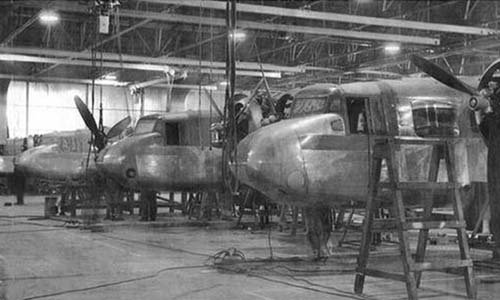Pictured above, the Blackburn Aircraft Factory in Dumbarton.
Aviation is an industry not widely associated with West Dunbartonshire's industrial heritage, however the early 20th century saw the introduction of the development and manufacture of several classes of aircraft: helicopters, spitfires, Sunderland flying boats and airships.
William Denny & Bros. were the first firm to become associated with aviation in 1906, Denny employees Edwin H. Mumford and J. Pollock Brown, designed a direct-lift air-craft, based on their research of ships' propellers. The first aircraft was built with a bamboo frame work, but this was a failure, as the bamboo absorbed water increasing the weight and making the air-craft too heavy for flight. The aircraft was destroyed by a storm in 1909 and later rebuilt using an aluminium framework. Test flights on the air-craft were carried out during 1912 - 1914, with several modifications being made to the air-craft. Late in 1914 the machine was taxied out onto the water and made a successful 'hop' of about 100 yards at a height of 10 feet. That same evening the air-craft was towed back to the shipyard and destroyed by a gale, due to the outbreak of the First World War the air-craft was never rebuilt. The air-craft is thought to be the earliest construction of a helicopter in Scotland. The demand for aircraft during the First World War saw Denny's build 150 BE2e training and reconnaissance aircraft for the Royal Flying Corps.
William Denny & Bros. re-entered the aviation industry in 1936, as a result of a business partnership between Sir Maurice Denny, Managing Director of William Denny & Bros and Robert Blackburn, of Yorkshires Blackburn Aeroplane and Motor Company. With the increasing possibility of war in the late 1930's the partnership between the two firms could not have came at a better time. Blackburn had already secured orders from the Air Ministry for aircraft and was looking for premises to expand production to fulfil orders, just as Maurice Denny was looking for an opportunity to enter the field of aviation.
The Blackburn factory was built at Barge Parkin 1937 close to the water front, making it ideal for the production and modification of the 'Shark', a spotter/reconnaissance airplane. The war years brought a contract to Blackburn to produce the Sunderland Flying boat, a four engine flying boat used for long distance transport, reconnaissance, U-boat patrols and search and rescue. The first Sunderland was completed in 0ctober 1941 and the last Sunderland left Dumbarton in October 1945, producing in total 241 Sunderland boats. At its peak the factory employed over 4,000 people from the local area. At the end of the Second World War the demand for aircraft dwindled and the Blackburn factory ceased production of aircraft. The Blackburn firm were asked to tender for the building of prefabricated housing, due to a national shortage of housing stock, the firm were successful and received an initial order in 1945. The firm built prefabs from 1945 - 1952. The Blackburn factory finally closed in 1960.
The William Beardmore & Co. Ltd., Dalmuir benefited greatly from the construction of airplanes during the First World War. Beardmores Naval Construction Works became involved with a remarkable range of war products which in addition to ships of all kinds included, aircraft, airships, tanks and fuses for shells. The company produced the Sopwith Pup aircraft under license, a single seater fighter aircraft used by the Royal Flying Corps during World War One. This model was soon replaced by the Beardmore WB III aircraft. The company produced and delivered over 100 of these aircraft to the Royal Naval Air Service. William Beardmore built the Inchinnan Airship Constructional Station at Inchinnan, just a mile or so over the river from Dalmuir to build airships, each of which was the size of an ocean liner. Here, he set out an entire airship works as well as housing for workers. Four great airships were built there from 1916 to 1921.
